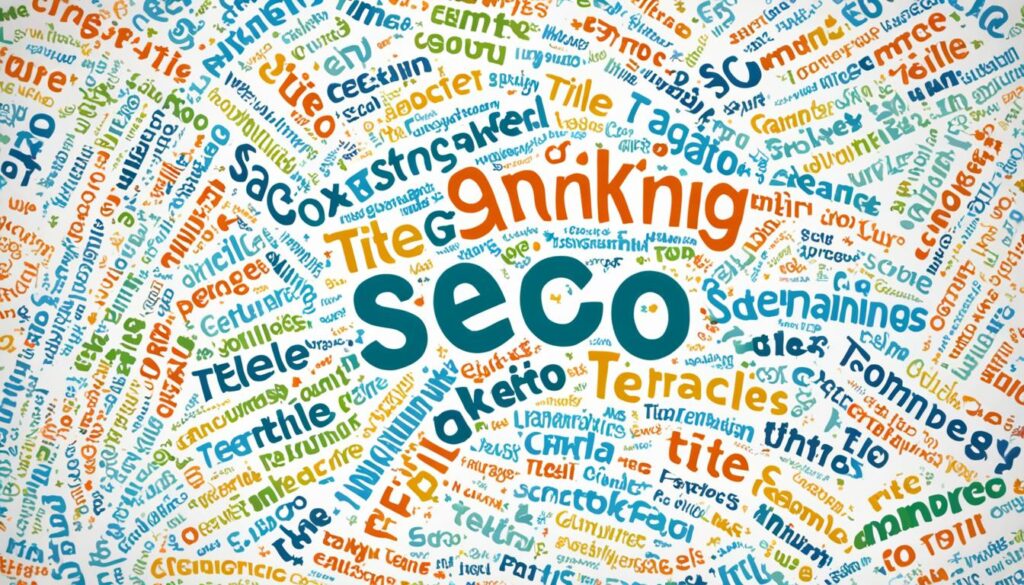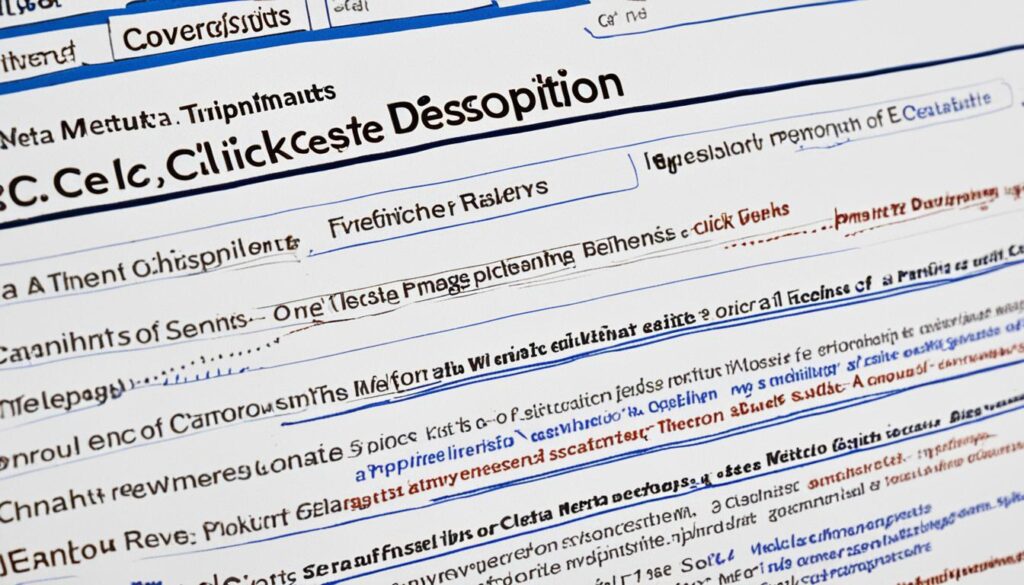When it comes to optimizing your website for search engines, you’re probably familiar with the importance of keywords, backlinks, and content quality. But did you know that there’s a hidden gem that can turbocharge your SEO efforts? We’re talking about meta tags.
Meta tags are the unsung heroes of SEO, providing vital information about your web page to both search engines and visitors. They hold the key to improved website ranking and increased visibility on platforms like Google. So, why are these small snippets of code so crucial?
Here’s a thought-provoking question for you: can a few lines of metadata really make or break your SEO game? How can you optimize meta tags to their fullest potential? And what role do they play in determining your website’s ranking on Google?
Get ready, because we’re about to dive deep into the world of meta tags. From meta titles and descriptions to meta robots and viewports, we’ll explore everything you need to know to maximize your SEO efforts. Let’s unravel the mystery, shall we?
Key Takeaways:
- Meta tags are snippets of code that provide crucial information about your webpage to search engines and visitors.
- Optimizing meta tags can significantly impact website ranking and visibility on platforms like Google.
- Meta tags include elements like meta title, meta description, meta robots, meta viewport, image alt attributes, and nofollow attributes.
- Best practices for meta tags optimization involve crafting unique, compelling, and concise meta titles and descriptions.
- Meta robots tags allow you to control how search engines crawl and index your web pages.
Meta Title
The meta title, also known as the title tag, is a crucial element of a web page’s meta tags. It serves as the clickable headline in search results and plays a significant role in describing the content of the page. To maximize the impact of your meta title on SEO, it is important to adhere to best practices.
Here are some key considerations when crafting effective meta titles:
- Keep them unique: Each page should have a distinct meta title that accurately represents its content.
- Be descriptive: The meta title should provide a concise summary of what the page offers.
- Keep it brief: Aim for a length of 60 characters or less to ensure it is fully displayed in search results.
- Follow proper capitalization: Write the meta title in either sentence case or title case, depending on your preference.
- Create click-worthy titles: Craft compelling meta titles that entice users to click and explore your webpage.
- Match search intent: Conduct keyword research to understand the phrases users are searching for and incorporate those relevant keywords into your meta title.
Adding a meta title to your page can be done by including the <title> tag within the <head> section of your HTML. Many content management systems, like WordPress, offer built-in functionality for setting the title tag, making it easier for website owners to implement this crucial element.
Here’s an example of how the <title> tag appears in HTML:
<head>
<title>SEO-Friendly Meta Title Example</title>
</head>
Implementing an effective meta title can greatly improve your webpage’s visibility in search results and increase the likelihood of attracting organic traffic.

Meta Title Best Practices
| Best Practices | Examples |
|---|---|
| Keep titles unique and descriptive. | Maximize Your SEO: Essential Meta Tags Guide |
| Limit meta titles to 60 characters or less. | The Importance of Meta Tags in SEO |
| Create click-worthy titles. | Boost Your Website Ranking with Effective Meta Titles |
| Incorporate relevant keywords to match search intent. | Unlocking SEO Success: Meta Titles 101 |
Meta Description
The meta description, also known as the description meta tag or SEO meta description, serves as a concise summary of the content on a webpage. It plays a crucial role in search engine optimization by providing searchers with a preview of what they can expect from the page.
A well-crafted meta description can attract more clicks and improve click-through rates, despite not directly influencing rankings. To optimize your meta description, follow these best practices:
- Make it unique: Each page should have a distinct meta description that accurately represents its content.
- Be accurate and concise: Summarize the page’s content in a clear and straightforward manner, using compelling language to capture the reader’s attention.
- Match search intent: Ensure your meta description aligns with the searcher’s query to increase the likelihood of attracting relevant traffic.
- Use target keywords strategically: Incorporate the primary keyword where it naturally fits within the description to give search engines a clearer understanding of the page’s topic.
- Limit the length: Keep your meta description under 160 characters to prevent truncation in search results.
Adding a meta description to your page is simple. Include the <meta name="description"> tag within the <head> section of your HTML, like so:
<head>
<meta name="description" content="Your meta description goes here">
</head>
By crafting compelling and informative meta descriptions, you can enhance the visibility of your web pages and increase the likelihood of attracting valuable organic traffic.

Meta Robots
The meta robots tag plays a crucial role in controlling how search engines crawl and index your web pages. By utilizing this tag, you can provide specific instructions to search engine bots, influencing their behavior and ultimately affecting how your site appears in search results.
When it comes to meta robots, there are several important attributes to be aware of:
- Index: This attribute allows search engines to include your page in their index. It is the default value and is typically used when you want your page to be discoverable by search engines.
- Noindex: By using this attribute, you can instruct search engines not to index your page. This can be useful for pages that you don’t want to appear in search results, such as duplicate content or private information.
- Follow: With this attribute, search engine bots are allowed to follow the links on your page. It is the default behavior and is typically used when you want to pass link authority to other pages.
- Nofollow: Using this attribute tells search engines not to follow the links on your page. It can be handy for preserving link authority and preventing search engines from associating your site with certain links.
It’s important to note that using incorrect or conflicting attributes in the meta robots tag can have a negative impact on your site’s visibility in search results. It’s recommended to follow best practices to ensure proper usage.
Best Practices for Meta Robots Tags
- Use meta robots tags only when you want to restrict how Google crawls a specific page. Not all pages require meta robots tags.
- Avoid blocking pages with meta robots tags in the robots.txt file. The robots.txt file is used to provide instructions to search engine crawlers, and it’s generally best to use the meta robots tag within the page’s HTML.
Adding a meta robots tag to your page is simple. Just include the following <meta name="robots"> tag in the <head> section of your HTML:
<meta name="robots" content="index, follow">Remember to replace “index” and “follow” with the appropriate values based on your specific requirements.
By correctly implementing meta robots tags, you can effectively control how search engines interact with your web pages, ensuring optimal visibility and relevance in search results.

Meta Viewport
In order to ensure that your webpage appears correctly on mobile devices, it is crucial to include the meta viewport tag in your HTML code. This tag plays a significant role in making your website mobile-friendly and optimizing its performance on different devices.
The presence of the meta viewport tag is also considered by Google as an indicator of mobile-friendliness, which directly affects your website’s rankings in search results. Therefore, it is essential to implement this tag correctly to enhance your website’s visibility and reach a wider mobile audience.
To optimize your meta viewport tags, it is recommended that you include them on all web pages. By doing so, you ensure a consistent and seamless user experience across your entire website, regardless of the device being used. Additionally, using the “standard” tag is generally sufficient unless you have specific design or layout requirements for certain pages.
To add the meta viewport tag to your page, simply include the following code within the
section of your HTML:
<meta name="viewport" content="width=device-width, initial-scale=1.0">
By following these best practices and incorporating the meta viewport tag into your HTML code, you can create a mobile-friendly and responsive design that improves user experience and positively impacts your website’s rankings in search engine results.

| Mobile-Friendly Website Benefits | Responsive Design Methods |
|---|---|
| Improved user experience | Fluid grid layouts |
| Higher search engine rankings | Flexible images and media |
| Broader audience reach | Media queries |
| Increased mobile traffic | Content prioritization |
Image Alt Attributes
Image alt attributes play a crucial role in optimizing your web page for search engines. They serve as descriptions of the image content and provide context when the image cannot be displayed. By using alt attributes effectively, you can improve accessibility and help search engines understand the images on your website.
When optimizing alt attributes, it is essential to focus on the most prominent images on your page. These are the images that are most relevant to the content and attract the most attention. By optimizing the alt attributes of these images, you can enhance the overall on-page optimization of your website.
When crafting alt attribute descriptions, make sure they are clear, descriptive, and natural. Avoid keyword stuffing and instead use keywords organically in the alt text where it makes sense. The goal is to provide accurate and helpful information about the image content to both search engines and visitors.
Adding alt attributes to your images is simple. Just include the alt attribute in the tag and provide a meaningful and relevant description of the image content. By doing so, you are not only making your website more accessible but also contributing to its overall search engine optimization.
Nofollow Attributes
In the world of SEO, there is a powerful tool called nofollow attributes that can have a significant impact on your rankings. Nofollow attributes are HTML attributes that indicate to search engines that a particular link should not be followed or considered when determining ranking positions. These attributes are particularly useful for managing outbound links and external references on your website.
When it comes to SEO, building relationships with other websites through outbound links is crucial. However, there may be instances where you want to use nofollow attributes on certain links. For example, if you have sponsored content or user-generated content, it’s important to use nofollow attributes to ensure that these links do not give an unfair advantage to the linked websites.
Implementing nofollow attributes is straightforward. You can add the rel=”nofollow” attribute to the <a> tag that contains the link you want to designate as nofollow. By doing this, search engines will not follow that particular link, and it will not impact your page’s rankings.
Using nofollow attributes requires a delicate balance. While they can be helpful for managing certain types of links, you should also exercise caution. It’s essential to avoid blocking entire pages with nofollow attributes in the robots.txt file, as this can have unintended consequences on your overall visibility in search results.
Here are some best practices for using nofollow attributes effectively:
- Use nofollow attributes only when necessary to ensure fairness and comply with search engine guidelines.
- Avoid blocking pages with nofollow attributes in the robots.txt file.
- Be cautious with the usage of nofollow on internal links, as it can limit the flow of link equity within your website.
By implementing nofollow attributes strategically, you can effectively manage outbound links and external references on your website, ensuring fairness while also maximizing your SEO efforts.

The Impact of Nofollow Attributes on SEO
| Benefits | Considerations |
|---|---|
| Allows you to manage outbound links and external references effectively | Using nofollow attributes excessively may restrict the flow of link equity |
| Ensures fairness for sponsored or user-generated content | Blocking pages with nofollow attributes in robots.txt can have unintended consequences |
| Helps maintain a healthy link profile | Using nofollow attributes on internal links can impact the flow of link equity within your website |
Heading Tags (H1-H6)
Heading tags play a vital role in structuring and organizing the content of your web pages. Although the impact of heading tags on SEO is subject to debate, the proper usage of the H1 tag holds significant value. These tags contribute to content organization and enhance the user experience, making it easier for both search engines and users to navigate through your page.
Best practices for heading tags include keeping them relevant to the text they describe, reflecting the sentiment of the content, and avoiding overuse or keyword stuffing. The H1 tag, in particular, should generally match the title of the page, providing consistency and clarity.
Heading tags from H2 to H6 can be used to further categorize and structure the content hierarchically.
Proper usage of heading tags
The primary purpose of heading tags is to serve as markers for different sections of your content. They help search engines decipher the importance and relevance of each section. By adhering to the following guidelines, you can optimize your usage of heading tags:
- Use the H1 tag for the main title: The H1 tag should be reserved for the main title or headline of your page. It should accurately summarize the main theme or topic of your content.
- Use H2 tags for subheadings: H2 tags are commonly used for subheadings that further elaborate on the main topic. They break down the content into manageable sections.
- Utilize H3 and subsequent heading tags for subsections: H3, H4, H5, and H6 tags can be employed to create subsections within larger sections. This helps to organize the content and create a logical structure.
By utilizing heading tags effectively, you can optimize content organization, improve user experience, and assist search engines in understanding the structure and hierarchy of your webpage. Keep in mind that search engines prioritize user experience, and properly formatted heading tags contribute to a user-friendly website.
Example of Heading Tag Usage:
| Heading Tag | Usage Example |
|---|---|
| H1 | |
| H2 |
Meta Title |
| H3 |
Proper usage of heading tags |
Conclusion
Implementing proper meta tags is essential for maximizing your SEO efforts. Meta title and meta description tags play a crucial role in improving click-through rates and increasing search engine visibility. By crafting unique, descriptive, and concise meta titles, you can attract more users to click on your website in search results. Additionally, well-written meta descriptions summarize your page’s content and entice users to visit your website.
Meta robots and meta viewport tags have a significant impact on how search engines crawl and display your web pages. Using the appropriate meta robots directives, such as index, noindex, follow, and nofollow, enables you to control the behavior of search engine crawlers on your site. This helps ensure that your most important pages are indexed while preventing unnecessary crawling of certain pages.
Ensuring mobile-friendliness is crucial in today’s digital landscape. By implementing the meta viewport tag, you can optimize how your website appears on mobile devices. This not only improves user experience but also boosts your site’s ranking potential as Google takes mobile-friendliness into account.
Image alt attributes are vital for enhancing accessibility and helping search engines understand your images. By providing clear and descriptive alt text, you can make your website more inclusive and improve its overall SEO performance.
Controlling the links on your website is essential for managing your site’s authority and directing search engine crawlers. Nofollow attributes allow you to specify which links should not be followed by search engines, giving you greater control over your website’s link profile.
Heading tags, including H1, H2, and H3, contribute to content organization and user experience. By using relevant and descriptive headings, you can guide both search engines and users through your content, making it easier to navigate and understand.
By following best practices and optimizing your meta tags, you can enhance your website’s visibility and improve its ranking potential in search results. Remember to keep your meta tags unique, accurate, and descriptive, and use appropriate attributes like nofollow and alt text to optimize your SEO strategies.
By prioritizing the implementation of proper meta tags and following SEO best practices, you can maximize the visibility of your website and increase its potential to rank higher in search results. So, start optimizing your meta tags today and watch your website climb the ranks!






